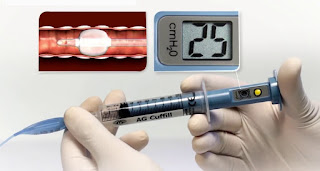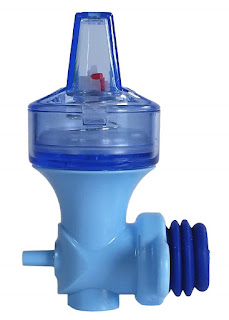Methods to stabilize ETT intracuff pressure
-The use of N₂O, which is well-known to diffuse into ETT cuffs, and the lack of frequent control of intracuff pressure (iPcuff) are the most important factors that contribute to the high incidence of excessive iPcuff during the perioperative period. Other factors, such as the diffusion of O₂ into the cuff and the warming of gases inside the cuff, play a small role in the increase in the iPcuff. Various factors affect the rate of diffusion of N₂O, including the difference in partial pressure of N₂O inside and outside the cuff, the area available for diffusion, and the cuff material. Prevention of overpressure of the ETT cuff can be achieved by several means:
1-Manual palpation of the pilot balloon:
-Free inflation of the cuff, controlled only by the anesthesiologist’s manual palpation of the pilot balloon, is not reliable and results in extremely variable iPcuff, ranging from 0-120 cmH₂O.
2-The pinch test:
-The pinch test represents an extension of the practice of palpating the pilot balloon of an ETT to verify the proper inflation of the cuff. The pilot balloon of the ETT is compressed manually between the anesthesiologist’s thumb and index finger until it is flat and the time to its reinflation is measured using a stopwatch. The regression analysis allowed the following equation to be developed for the restoration time (T) in sec. as a function of the (Pcuff) in cmH₂O: [T = 2.72 − 0.041 * Pcuff].
3-Simple on-line relief valve:
-It is a simple and inexpensive method to gauge the Pcuff by using a regular 20-ml syringe attached in line with the connector of the ETT cuff. The syringe is connected to the tube cuff and inflated with 15 ml of air and is left constantly connected to the cuff. This results in an adequate venting of the excess iPcuff and also there is no leakage around the cuff.
4-Automatic regulation of the cuff pressure:
-The procedure requires only a simple aquarium air pump and conventional tubing. The procedure devised to maintain ETT Pcuff is readily implemented, cheap, easy to operate and can be used regardless of the specific ventilator or tube used.
5-The Pcuff monitoring devices:
a) ETT Intracuff Pressure Manometer: (Figure 1)
 |
| Figure 1: ETT Intracuff Pressure Manometer |
b) AG Cuffill Cuff Inflator with Integrated Manometer: (Figure 2)
 |
| Figure 2: AG Cuffill Cuff Inflator with Integrated Manometer |
c) Tru-Cuff ETT Cuff Pressure Syringe: (Figure 3)
 |
| Figure 3: Tru-Cuff ETT Cuff Pressure Syringe |
d) Vortan Cuff Inflator: (Figure 4)
 |
| Figure 4: Vortan Cuff Inflator |
e) AccuCuff Cuff Pressure Indicator: (Figure 5)
 |
| Figure 5: AccuCuff Cuff Pressure Indicator |
f) PressureEasy Cuff Pressure Controller: (Figure 6)
 |
| Figure 6: PressureEasy Cuff Pressure Controller |
6-Profile Soft-Seal Cuff (PSSC) ETT:
-The Profile Soft-Seal Cuff (PSSC; Sims Portex, Kent, UK), made of a material impervious to N₂O, velvet soft polyvinyl chloride, a new material with N₂O gas barrier properties produces a thin and highly compliant cuff without increasing N₂O diffusion, thereby reducing the increase of iPcuff and postoperative sore throat.
7-Portex Soft-Seal tube cuff:
-In the Portex Soft-Seal tube cuff (Portex Ltd., Hythe, UK), the plasticizer added to soften the polyvinyl chloride makes the cuff much less permeable to N₂O despite having a thickness of 0.06 mm, which is very similar to the Mallinckrodt Lo-Contour (Athlone, Ireland). The new design prevented increases in the iPcuff and remained stable.
8-Repeated deflation of Air-filled ETT cuff:
-In clinical practice, some anesthesiologists perform a simple method of repeated cuff deflations to inhibit excessive pressure, and eventually, the Pcuff stabilizes. Immediately after TI, the ETT cuff is aspirated as much as possible and then inflated with the smallest volume of air that would produce 12-14 mmHg of Pcuff and seal the airway when the intra-airway plateau pressure is 18 cmH₂O.
-During 67% N₂O anesthesia, gases in the cuff are aspirated every 30 min. in the Trachelon (Terumo, Tokyo, Japan) or 60 min. in the PSSC ETT (Sims Portex, Kent, UK) for 4 h. to decrease the Pcuff to the initial pressure. Pcuff should stabilize when the N₂O concentration is equivalent on both sides of the cuff wall. Therefore, equilibration of the N₂O concentration after repeated deflation for 4 h. is the underlying mechanism of this simple technique. The increased compliance of the PSSC ETT cuff, rather than the N₂O gas barrier, contributes to the requirement for longer intervals between cuff aspirations to avoid excessive pressure compared with what is needed for standard ETTs.
9-N₂O-O₂ gas mixture-filled ETT cuff:
-Immediately after intubation, the cuff is aspirated as much as possible and then inflated with the smallest volume of 40% N₂O and 60% O₂ that would not leak when the intra-airway plateau pressure is 18 cmH₂O. The N₂O gas mixture to fill cuffs is aspirated from the common gas outlet of an anesthetic machine.
-Inflating cuffs with 40% N₂O maintains stable Pcuff without excessive iPcuff or air leaks during anesthesia with 67% N₂O; however, deflationary phenomena of the cuff might occur because iPcuff decreases so quickly after substituting oxygen for N₂O, therefore, it is suggested that the Pcuff be checked frequently to avoid air leaks and aspiration of gastric contents during prolonged emergence from anesthesia or during transportation of patients with TI.
-The ETT with the N₂O gas-barrier type of cuff might be beneficial because of the longer time required to decrease Pcuff after cessation of N₂O administration and that the highly compliant cuff might be the mechanism of slow changes of iPcuff in the PSSC.
10-Saline-filled ETT cuff:
-When saline is used to fill the cuff, the lack of pressure increase secondary to N₂O diffusion depending on the physical principle that liquids do not expand in volume when highly soluble gases dissolve in them.
11-Lidocaine-filled ETT cuff:
-Lidocaine placed inside the cuff of an ETT can slowly diffuse through its hydrophobic structure. The ETT cuff is prefilled with 7 to 8 ml of L-HCl 2% (140-160 mg) for 90 min. before intubation to enhance the diffusion of lidocaine across the cuff then the cuff is evacuated before intubation. Following intubation, the ETT cuff is inflated with enough lidocaine to prevent retrograde leak at a tidal volume of 10 ml/kg.
12-Alkalinized lidocaine-filled ETT cuff:
-Alkalization of lidocaine can promote the in vitro diffusion across the ETT cuff many tens of times. The cuff of the tracheal tube is initially inflated slowly with saline until no leak is heard under controlled ventilation, after the initial injection of 2 ml of L-HCl 2% (40 mg) into the ETT cuff, a supplementary volume of 2 ml of 8.4% NaHCO₃ is added. It has been shown that small amounts of L-HCl diffused slowly across the ETT cuff; the addition of NaHCO₃ increases the diffusion and dramatically increases the amount of lidocaine released. Plasma lidocaine concentrations increase when lidocaine is alkalinized (Cmax is 62.5 ± 34.0 ng/ml) versus (3.2 ± 1.0 ng/ml) without NaHCO₃. Alkalinization of L-HCl with NaHCO₃ allowed the diffusion of 65% (versus 1% without NaHCO₃) of the neutral base form of lidocaine for 6 hours.
-Use of a small dose of alkalinized lidocaine markedly improves ETT tolerance during a more prolonged time and offers the advantages of minimal stress response to smooth extubation and cough-free emergence.
























